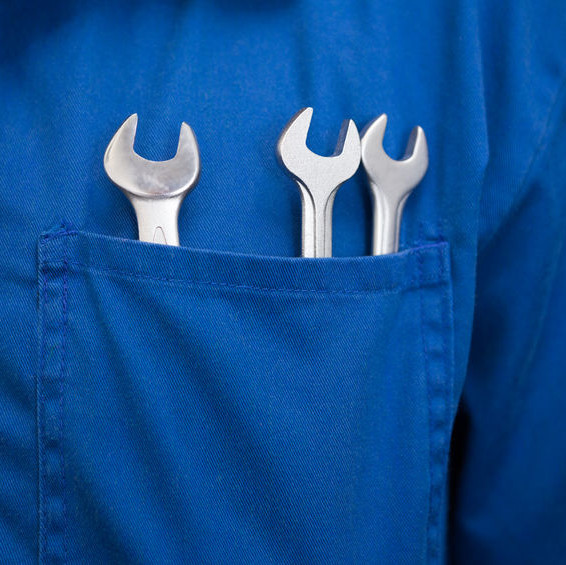
Maintenance
What is maintenance?
Maintenance allows for the plant machinery and equipment to run smoothly without downtime and postponement of production. It is an essential prerequisite program of a food processing company.1
Food processing equipment and machinery of bakeries, like those of all industrial plants, is susceptible to failure through breakdown and deterioration in performance owing to wear and tear with time.
- Inspection/Checking
- Replacement
- Lubrication
- Repair
Types of maintenance1
- Preventive maintenance: Planned program of checks, services, and repairs designed to avert equipment failure or building deficiencies
- Corrective maintenance: Scheduled work to improve the quality or performance of malfunctioning or broken equipment and restore it to proper working condition
- Unscheduled maintenance: Reactive in nature, occurring immediately when a critical repair is needed, often during unpredicted breakdowns
- Temporary repairs: Short-term repairs that use a variety of approved temporary materials and that are replaced with a permanent repair as soon as possible
Regulatory compliance
Maintenance of a food plant’s premises, machinery, and equipment is thoroughly addressed in 21 CFR Part 117 (Current Good Manufacturing Practice, Hazard Analysis, and Risk-based Preventive Controls for Human Food). The following are a few examples:
- All plant equipment and utensils used in manufacturing, processing, packing, or holding food must be so designed and of such material and workmanship as to be adequately cleanable, and must be adequately maintained to protect against contamination.
- Instruments and controls used for measuring, regulating, or recording temperatures, pH, acidity, water activity, or other conditions that control or prevent the growth of undesirable microorganisms in food must be accurate and precise and adequately maintained.
- Equipment, containers, and utensils used to convey, hold, or store raw materials and other ingredients, work-in-process, rework, or other food must be constructed, handled, and maintained in a manner that protects against contamination.
- Properly store equipment within the immediate vicinity of the plant that may constitute an attractant, breeding place, or harborage for pests.
- Grounds must be designed, constructed, and maintained so that they do not constitute a source of contamination in areas where food is exposed.
- Buildings, fixtures, and other physical facilities of the plant must be maintained in a clean and sanitary condition and must be kept in repair adequate to prevent food from becoming adulterated.
- Seams on food-contact surfaces must be smoothly bonded or maintained so as to minimize accumulation of food particles, dirt, and organic matter and thus minimize the opportunity for growth of microorganisms and allergen cross-contact.
- Holding, conveying, and manufacturing systems, including gravimetric, pneumatic, closed, and automated systems, must be of a design and construction that enables them to be maintained in an appropriate clean and sanitary condition.2
Relevance
Maintenance of bakery equipment and machinery includes:
- Regular and planned inspection/checking (assessment of the equipment’s overall condition and integrity, e.g., whether it is working properly)
- Replacement of worn, rusty, damaged, loose, flaking, and broken parts
- Lubrication of drives, motors, bearings, chains, etc.
- Welding, repair and/or adjustment of loose parts on equipment prone to vibration, chemical reaction, friction and/or fatigue.[3]
Building components of a bakery that require maintenance are:
- Walls and windows
- Floors
- Ceilings
- Supports
- Walkways
- Ramps/Platforms
- Dock levellers
- Drains
Equipment (processing and ancillary), and machinery of a bakery that require maintenance are:
- HVAC systems
- Sieves/Screens
- Dough pumps/Augers
- Pipelines for liquids transport (e.g., process water, liquid sugar, CIP cycles)
- Conveyor bands
- Weighers and ingredient feeders
- Fermentation tanks
- Mixers/Kneaders (Planetary/Spirals)
- Molders/Dividers/Rounders
- Proofers
- Ovens
- Slicers (blades)
- Packaging lines
Components
Every food plant requires a well designed and properly implemented maintenance program. The goal of the is to preserve the process environment to optimize production and minimize food safety risks and equipment failures. The program should be preventive, rather than corrective, in order to increase productivity, quality, and safety and to minimize the potential for contamination or adulteration.
The components are:
- Inventory of all machinery and equipment parts that are critical to food safety
- Master plan (schedule) of preventive maintenance activities
- Identification of food-contact surfaces (zoning)
- Procedures for the prioritization of maintenance work orders
- Identification of chemicals, which includes guidelines, safety instructions, and segregation conditions for lubricants (food-grade and nonfood-grade), release agents, soluble oils, and heat transfer fluids.
- Procedures for maintenance activities, which include dismantling and reassembly instructions according to each equipment and/or part
- Documentation of maintenance procedures and instructions
- Documentation of maintenance forms
- Recordkeeping of maintenance activities
- Education and training of personnel responsible for the maintenance program
References
- AIB International. “The AIB GMP and Prerequisite Guide,” Chapter 7.
- U.S. Food and Drug Administration. “21 CFR 117 – Current Good Manufacturing Practice, Hazard Analysis, and Risk–based Preventive Controls for Human Food.” 1 Apr. 2017, https://www.accessdata.fda.gov/scripts/cdrh/cfdocs/cfcfr/CFRSearch.cfm?fr=117.130
- Moerman, F. “Personal Hygiene and Good Maintenance Practices for the Servicing of Food Processing Equipment.” Food Protection and Security: Preventing and Mitigating Contamination during Food Processing and Production, Elsevier Ltd., 2017, pp. 287–325.

